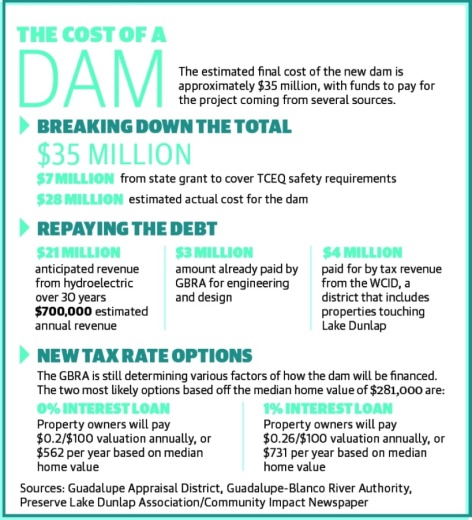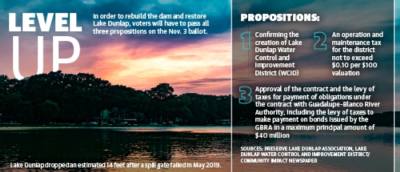been working on a restoration plan that will help local property owners and revitalize the area’s economy.
The lower water levels have created a number of problems for residents. The issues range from numerous homeowners stating their property values have declined to greatly diminished lake recreation that has led to drops in certain aspects of the local economy. Residents with homes along the lake were left with docks hovering up to 18 feet above the muddy ground, and property values are expected to drop an average of 28% this year, according to the Guadalupe Appraisal District. The incident that occurred May 14, 2019, has left residents of Lake Dunlap with a complex choice Nov. 3: Finance a project that will repair the dam, bring water levels back to normal and subsequently increase their annual tax bill by several hundred dollars, or adjust to the new normal—a trickling creek where a lake used to be.
“To see that lake just draining out and seeing the exposed lake bed at the bottom was just a sad, sickening sight,” resident Doug Harrison said. “It’s just heartbreaking to go from this beautiful lake to just a little river running down the middle.”
Engineering a way forward
According to resident John Moore, property owners were initially angry with the GBRA for failing to maintain the dam at Lake Dunlap as well as other dams in the system. In 2016, the dam at Lake Wood also failed and has not been restored.
Reports from the GBRA following the incident indicated that a lack of maintenance and funding left the entire system vulnerable. The GBRA initially planned to lower the water level of the remaining four lakes before being blocked by two lawsuits.
In June, residents and area leaders met to discuss funding to restore the dam and how to partner with the GBRA, Moore said.
“If we don’t cooperate, and if we don’t work together and find a common ground, then we’re ... not going to have a lake,” Moore said.
The dam was originally constructed in 1931 to provide hydroelectric power to the area. It created a 9-mile, 410-acre lake along the Guadalupe River and is one of six dams owned and operated by the GBRA in Central Texas.
Immediately following the failure, board members of the Preserve Lake Dunlap Association worked with local representatives to propose a water control and improvement district, or WCID, that would allow residents to tax themselves to pay for the improvements, said Harrison, who serves as a special advisory board member for the PLDA.
A WCID is a type of governmental entity with the authority to finance, build, repair and maintain dam facilities, according to the Texas Commission on Environmental Quality.
PLDA President J Harmon said the GBRA had to approve a memorandum of understanding recognizing the PLDA’s intent to create a WCID before plans could move forward, which it did on Oct. 23, 2019.
Harmon said the PLDA began having meetings with the GBRA to create a plan that worked both for the GBRA and taxpayers. On Feb. 7, 2020, the TCEQ approved the Lake Dunlap WCID, and a temporary board with five members was established to work with the GBRA to determine tax rates and develop a design for the dam.
“What we have arranged with GBRA to do is they’re going to borrow the money using their triple-A credit rating and their connections with Texas Water Board,” Larry Johnson said. “Then our role for the WCID is essentially going to be the financing mechanism.”
Johnson was previously a member of the WCID board before becoming treasurer of the Committee to Restore Lake Dunlap, a political action committee formed to promote the WCID among voters.
GBRA Communications Coordinator Patty Gonzales said the GBRA has applied for an interest-free loan and low-interest loans from the Texas Water Development Board for the replacement and repair projects.
“Bonds will be issued by the GBRA for the project, and the debt service will be paid for by a pledge of tax revenues from taxpayers on the lake,” Gonzales wrote in an email.
The estimated cost of the dam is $35 million, and like all dams in the GBRA system, it will be hydroelectric. However, Johnson said the amount the WCID would borrow over a 30-year period will be determined after the project is awarded to a contractor.
In addition to taxpayer money, the GBRA has committed to diverting revenue from the sale of energy produced by the hydroelectric dam, which Johnson said is an average of $750,000 per year, though the PLDA budget anticipates $700,000 in revenue annually.
“Lake Dunlap has historically produced enough renewable clean energy to power 1,500 homes every year,” Johnson said.
If the GBRA is able to secure an interest-free loan, the WCID estimates that property owners within the district will pay $0.20 per $100 valuation, while a 1% interest loan would require a tax rate of $0.26 per $100 valuation.
According to information from the WCID, the median home value on the lake is $281,000. That makes the median property tax for the WCID $562 per year with a 0% interest loan and $731 per year with a 1% interest loan.
Though the ultimate tax rate levied by the project is yet to be determined, other facets are well underway.
In addition to revenue from the dam’s hydroelectric energy going back into the project, the GBRA has already paid $3 million for initial engineering work, which includes stop logs and other safety features.
“Stop logs make it very safe and very easy to maintain the dam, which is something we’ve never had, so it was essentially impossible to get to the most critical part of the old gates, and that’s the part that broke,” Johnson said.
A three-part proposition
The next step, Harrison said, will be receiving voter approval for three propositions on the November ballot.
Proposition A would officially form the Lake Dunlap WCID, which is the first step in allowing the residents to tax themselves to rebuild the dam.
Proposition B would set an upper limit on the WCID maintenance and operation tax rate at $0.10 per $100 valuation, and Proposition C would give the WCID the authority to levy a tax to repay bonds issued by the GBRA for the dam construction up to $40 million.
The operation and maintenance tax rate is planned to be $0.03 per $100 valuation, and the dam is estimated to cost $35 million.
Voting for the three propositions was originally slated for May 2 but was postponed until the Nov. 3 election due to the coronavirus pandemic.
Johnson said approximately 1,080 voters are registered in the district, and all three propositions must pass in order to move forward with financing and construction.
“We’re really trying to get people to understand that this is the only plan there is,” Johnson said. “There’s no plan B.”
Because of the pandemic, PLDA members have begun utilizing direct online outreach, social media campaigns and one-on-one meetings with residents to share the plans in lieu of large public meetings.
“We can’t have any large meetings, and so we’re doing it grassroots door to door,” Harmon said. “To us, this is bigger than the presidential election.”
The GBRA plans to open the project up for bids by early October and will hopefully have a final cost before the election, Harmon said.
The next steps
Should voters approve all three propositions, the GBRA would finalize the loan, and construction could begin as early as the end of this year, Harrison said.
However, if one or more of the propositions do not pass in November, many members of the PLDA have said they are concerned that the project will lose public interest, repairs will not be made and the lake will remain low.
“We all remember what a great place Lake Dunlap used to be,” Johnson said. “The longer that it takes to get past this next step, the more people get used to what they see.”







